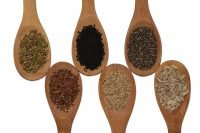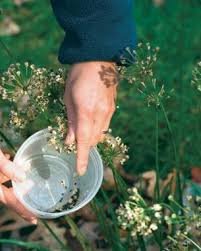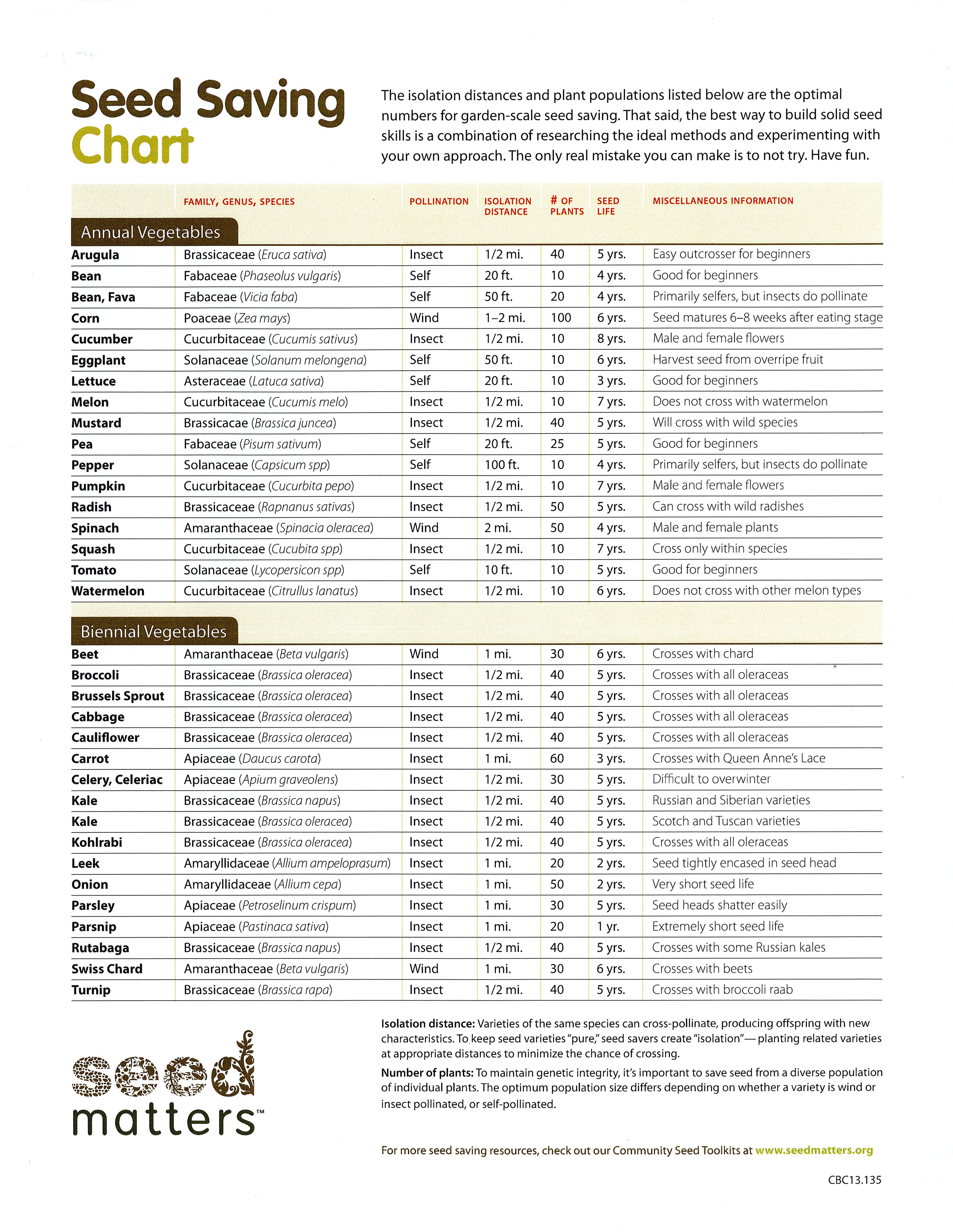Seed Library Newsletter
Sign-up for our Seed Library Newsletter!
Spring 2024
Top 5 Activities For Spring Gardeners
(Info borrowed from Peaceful Valley Farms)
It’s April, and Spring is finally here! There are many activities needed in the garden in the spring, from clean-up to planting and weeding. These are the Top 5 recommended activities for spring gardeners across the country.
1) Start Your Summer Seeds: April is probably the last opportunity for you to start some of your warm-season vegetables like eggplant, tomatoes, and peppers. These grow slowly, so the earlier you get them started, the better. March is best, but you can start in April, especially in a colder zone. As soon as your seed starts to have its first real leaves, you can feed them with a diluted fertilizer. Ensure you have a good supply of Agribon or frost blankets for those late frosts that come in April and early May.
2) Plant Some Spring Potatoes: April is a super time to plant your tubers! Plant red, purple, yellow, or white potatoes. Or try something new like a fingerling seed potato. Potatoes are fun and easy to grow in the ground or in a container.
3) Get Your Compost Cookin’: When T-shirt weather arrives, you can be sure that your compost pile is starting to heat up. This is a good time to give it a great boost with a variety of meals (blood, bone, feather, alfalfa, or kelp or a combo of two or more) and some potassium sulfate. If you don’t already have a compost pile, check out this Composting 101 video from Groworganic.com.
4) Plant Some Spring Wildflowers: Spring is a good time to plant wildflowers, especially in cooler regions.
5) Spring Cleaning: Clean up any debris around the garden, like leaves, branches, dropped fruit, or forgotten vegetables. These can be a great hiding place for pests and diseases. Add this to your compost pile but leave out anything you think may be diseased. If you haven’t already done it, clean your greenhouse or hoop house to prepare for starting your warm weather seeds. Be sure to clean up beneath your flowering bushes to prevent blight caused by a fungus.
Winter 2023/24
A thriving vegetable garden doesn’t have to end when summer does. As the days grow shorter and the fall chill sets in, it’s a good time to think about your winter garden. With a little bit of planning, and preparation you can grow vegetables well into the winter months.
For some of the more bitter vegetables, a natural reaction to the cold is the production of extra sugars, making them sweeter when they come into contact with a frost. These vegetables will do well & some actually thrive during colder weather:
Spinach
Onions/leeks/scallions
Peas
Cabbage/broccoli/Brussels Sprouts
Radishes
Lettuce/Greens/Chards/Kale
Carrots
Turnips/Parsnips/Rutabagas
Garlic
Potatoes
Cauliflower
Broad Beans
Kohlrabi
Beets
Celery
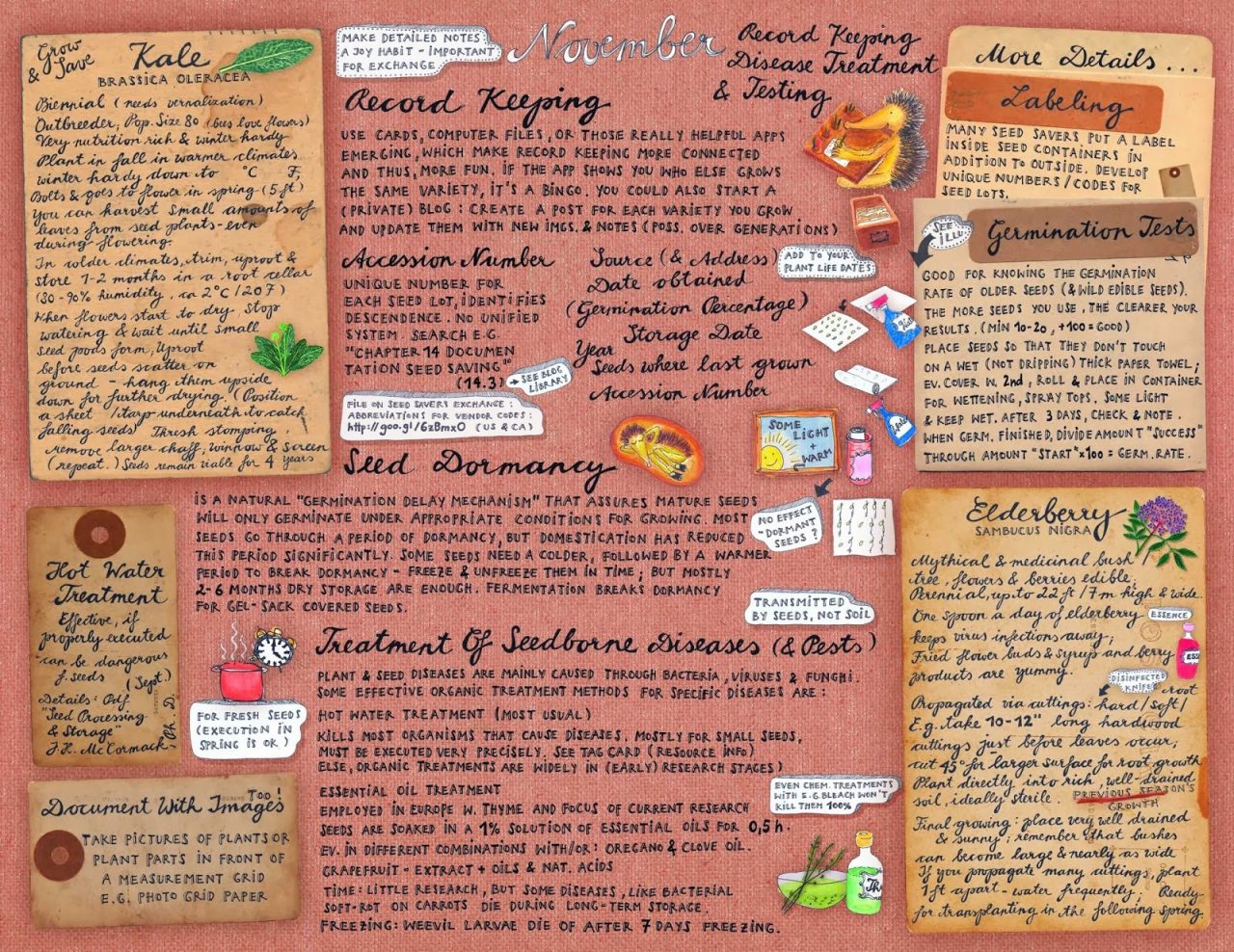
Seed Saving Tips
**Reminder: Seeds are still available to request (up to 20 seed packets total per individual card holder).
See details and access the Mendocino County Seed Library request form HERE..
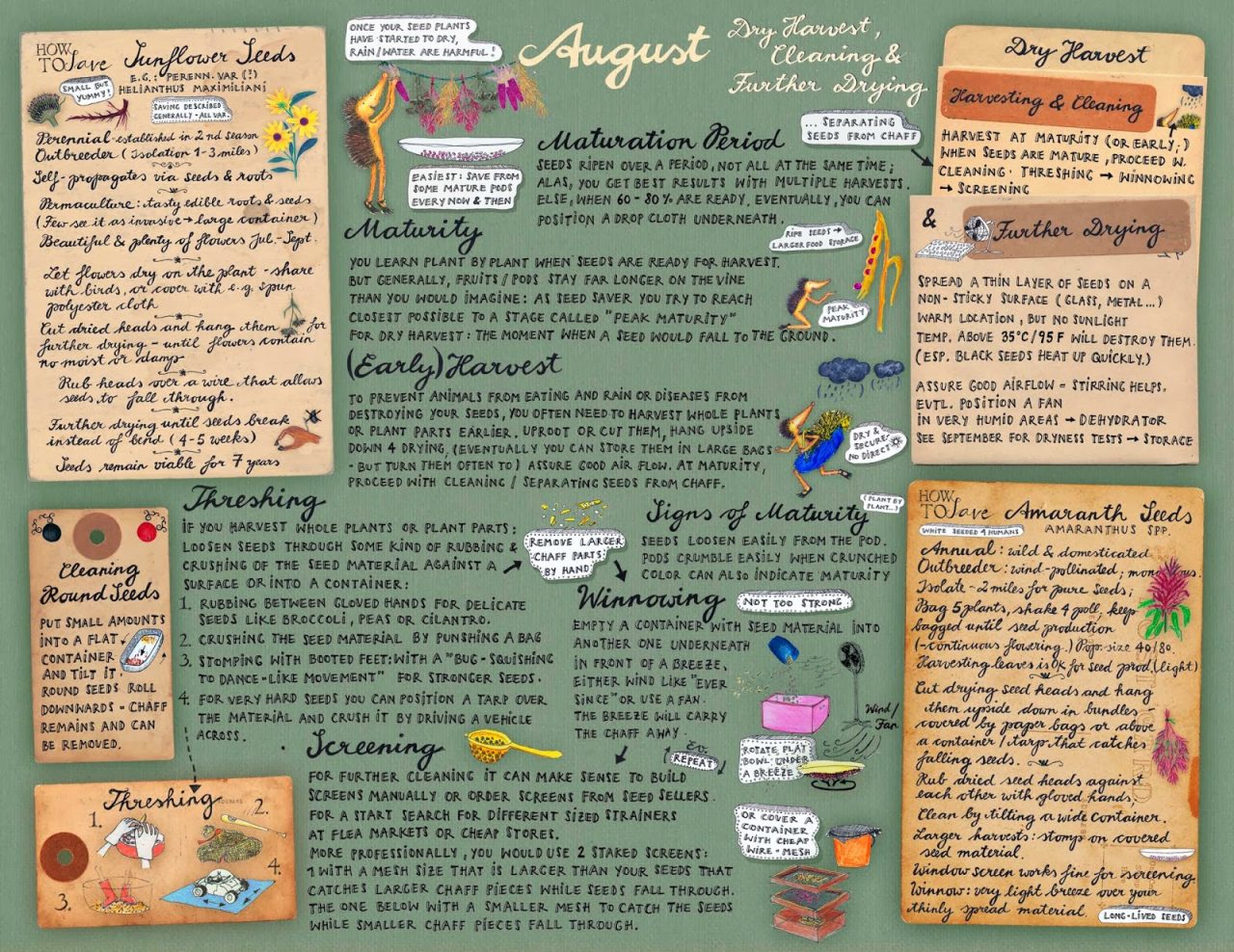
While everyone is busy reaping the bounties of their planted crops, now is the time to keep in mind the end of harvest season and seed saving. Each year, to replenish your seed reserves (and, hopefully, save a little extra to donate to the Fort Bragg Seed Library!), let a few of your mature open-pollinated plants go to seed. As they are “seeding”, check out these helpful links on how to prepare those seeds for saving.
First, follow our Mendocino County Seed Library Facebook page. There are daily postings of helpful planting tips, harvest ideas and seed saving tips.
Next, check out these websites and blogspots:
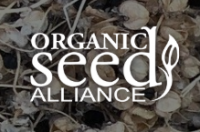
“Grow seed for the common good: Leading education, research and advocacy to advance organic seed”
Helpful seed saving publication found on their website:
Seed Alliance Seed Saving Guide.pdf
 Seed Savers Exchange has tons of useful gardening and seed saving tips. They even have resources for finding those seeds you can’t seem to find anywhere else.
Seed Savers Exchange has tons of useful gardening and seed saving tips. They even have resources for finding those seeds you can’t seem to find anywhere else.
“The Alliance for Sustainability: Sustainable, thriving communities where we live.”
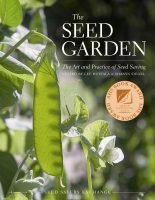 Additionally, if you find it easier to learn seed saving from a book or DVD you are in luck! We have tons to choose from. Check out the link below for items you can request and pickup curbside today!
Additionally, if you find it easier to learn seed saving from a book or DVD you are in luck! We have tons to choose from. Check out the link below for items you can request and pickup curbside today!
Books and DVDs in our Find! catalog. Search keywords are Seed Saving.
And last, some great seed saving tutorials we found:
Planting Chart for Mendocino County
Mendocino County has a varied set of climes all at once within its bounds. Mendocino County’s Local Food Guide has put together a planting chart specifically designed to address all of those areas, giving us the best information on what grows well in our little part of the county. Click here to obtain the chart.
Winter Newsletter
December 2018
What is Soil Health?
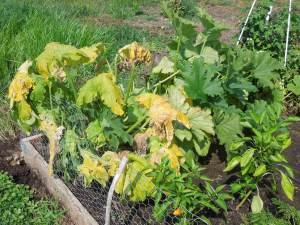 We all want the plants in our gardens to grow strong and healthy but what if they don’t? If your plants are growing well, you may not have to worry about it. However, from the Master Gardener Handbook 2nd Ed.: “because most nutritional disorders of plants are difficult to diagnose from visual symptoms alone, tissue and soil analysis are often needed as well. In some instances, plants may not show symptoms of nutritional deficiencies until severe stress has occurred. So, what do you do if your leaves are discolored or falling off? Or your plants grow but don’t produce? Sadly, it could be due to your soil’s health rather than the plants themselves.
We all want the plants in our gardens to grow strong and healthy but what if they don’t? If your plants are growing well, you may not have to worry about it. However, from the Master Gardener Handbook 2nd Ed.: “because most nutritional disorders of plants are difficult to diagnose from visual symptoms alone, tissue and soil analysis are often needed as well. In some instances, plants may not show symptoms of nutritional deficiencies until severe stress has occurred. So, what do you do if your leaves are discolored or falling off? Or your plants grow but don’t produce? Sadly, it could be due to your soil’s health rather than the plants themselves.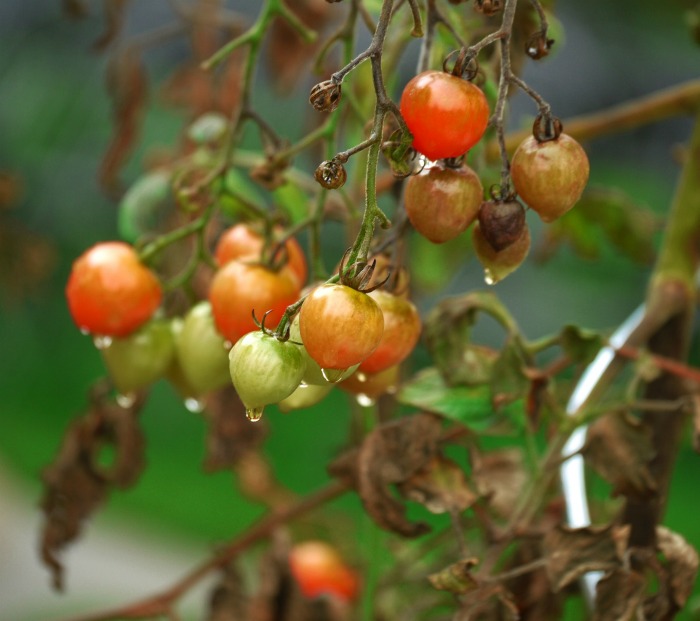
Soil health is defined as the ability of the soil to continually work as a thriving ecosystem that sustains life. Knowing the condition of your soil is vital to this function and every year provides a new chance to learn more about your soil and improve its health.
To learn how to improve your soil’s health you need to know there are three basic types of soil textures: sand, silt and clay. If you don’t know what type of soil your garden has you can check this chart to help determine its texture. You can’t change the texture of your soil but you can manage it using organic material, microorganisms, choice of plants used, nutrients and water flow.
Once you determine your soil’s texture you can learn what grows best with its properties. The University of North Carolina Extension has a great article here on soil properties.
 Now that you know your soil and what grows best with it’s properties, the key to achieving healthier soil is building soil organic matter using the 4 basic principles the Natural Resources Conservation Service division of the USDA put together in their checklist for establishing and improving soil health. They are: minimizing disturbance (no till, low till, mulch tillage); maximizing soil cover (cover crop, mulching); maximizing biodiversity (diverse crop rotation, cover crop, no till, low till, holistic pest management, holistic nutrient management); and maximizing the presence of living roots (diverse crop rotation, cover crop, no till, low till). Using these 4 techniques, one should be seeing an improvement in the overall health of their plants.
Now that you know your soil and what grows best with it’s properties, the key to achieving healthier soil is building soil organic matter using the 4 basic principles the Natural Resources Conservation Service division of the USDA put together in their checklist for establishing and improving soil health. They are: minimizing disturbance (no till, low till, mulch tillage); maximizing soil cover (cover crop, mulching); maximizing biodiversity (diverse crop rotation, cover crop, no till, low till, holistic pest management, holistic nutrient management); and maximizing the presence of living roots (diverse crop rotation, cover crop, no till, low till). Using these 4 techniques, one should be seeing an improvement in the overall health of their plants.
Still not sure about your soil’s texture and health? Get it tested. You can have your soil tested by sending a sample to one of the laboratories listed here. Home testing kits are available but according to the USDA, they aren’t very reliable. If you’re really concerned about your soil’s health, it would be better to spend a little money to get a more accurate reading than to rely on a home tester.
To all of our seed library patrons out there…Have a wonderful holiday season and a Happy New Year of gardening! See you at the (Seed) Library!
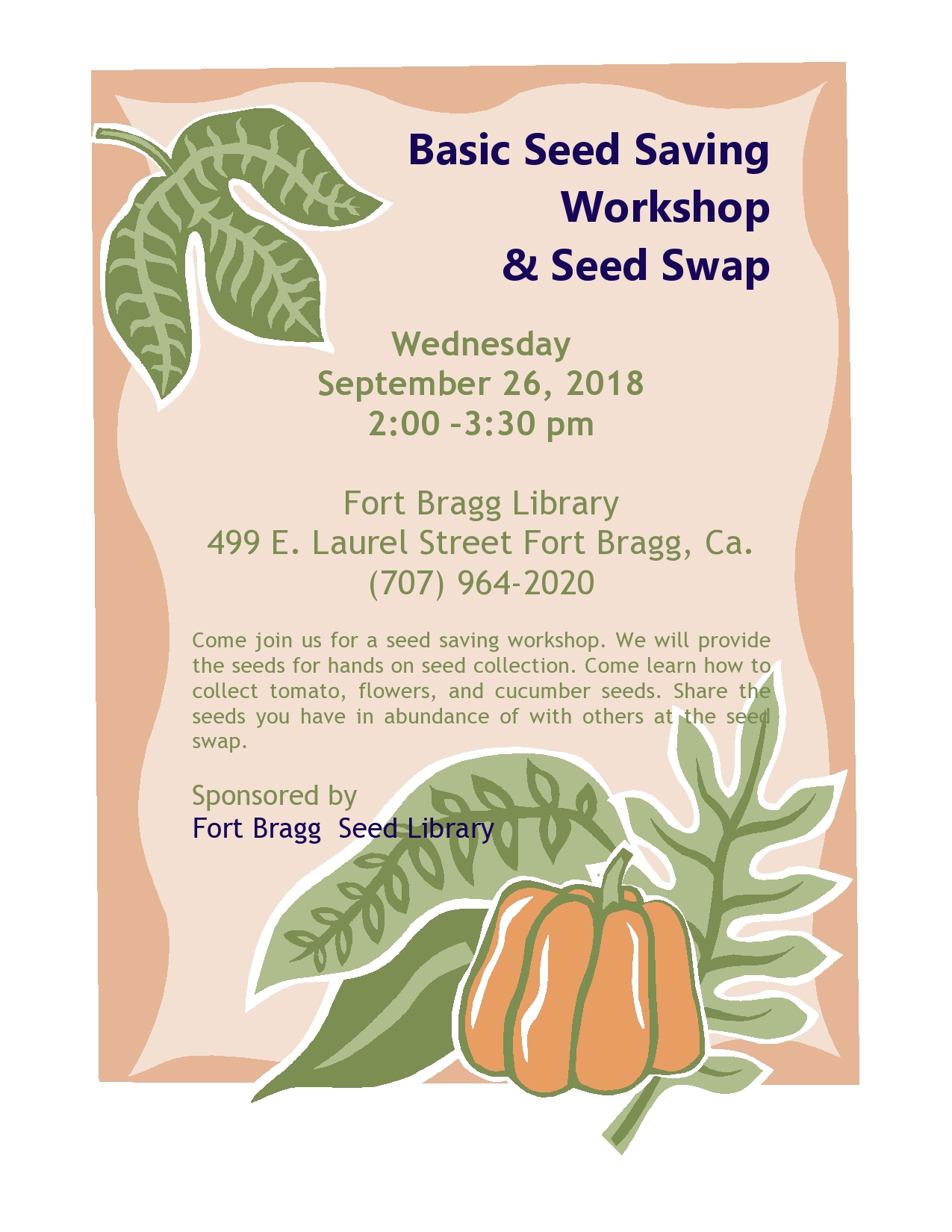
Spring Newsletter
June 2018
 Stories of Seeds
Stories of Seeds
Highlights from our Collection
We want to hear your story! Take a picture of a plant you have saved seeds from and let us know what dishes you’ve made with this plant or share your favorite recipe using this plant. We will highlight a plant in our collection each of the summer months this year.
Submit your photos and short story to: Carole Poma, Fort Bragg Seed Library Coordinator, either in person or via email (fortbraggbranchlibrary@gmail.com).
Help Us Grow Local Seed 
Our intention is to grow more local seed for the benefit of the community. We are focusing on preserving the local varieties that have significance, are rare or unusual, while increasing food security and local resilience.
How can you help?
-
Grow out seed. Start with super easy plants. Check with the seed librarian for seeds that are easy and fun to grow for your first grow out.
-
Join the Fort Bragg Seed Library – we are a group of individuals, seed librarians, non-profit growers working together with a vision to create a network of local seed growers.
-
Learn the names and needs of local plants. Grow these in your garden. Keep the old time plants of your grandmother or bring them back. Learn some history about your plant as your go.
 Grow Out Program
Grow Out Program
Return quality seed that is well labeled. Use our information sheet to provide information on how your seed was grown and where. Note: some plants readily cross pollinate, such as sunflowers, corn and brassicas. If you are saving seeds from these plants and did not cage or hand pollinate them, PLEASE note this on your return package.
Seed Collecting 101 Workshop
September 2018
Watch for flyers on our Seed Collecting 101 class coming in September 2018. This will be a “hands on” class for those who have never collected seed and would like some practical experience before going it alone.
Winter Newsletter 2017
Our gardens have long since been put to bed and last summer’s seeds have been saved and stored. Those with winter gardens continue to harvest but those of us who prefer spring gardens will just have to wait out the weather in anticipation of longer days and plentiful sunshine.
In the meantime, let’s talk about seeds…
HEIRLOOM, HYBRID, OPEN-POLLINATED: a Guide (from BountifulGardens.org)
What do all those terms really mean?
And why do they matter?
We started Bountiful Gardens with the idea that people could grow their own food without weird chemicals, and save their own seed, just as gardeners have done for generations. At the time, the seed industry was replacing traditional open-pollinated varieties with hybrids developed for agribusiness. Now, we face the new threat of genetically-altered crops. Here’s a guide to the terms:
TRADITIONAL PLANT BREEDING starts by pollinating the flower of a plant with pollen from a related, but slightly different, variety. Then, over several generations, the plants are selected for certain traits. In this way, broccoli, for example, became different from the tough wild plants that are its ancestors.
OPEN-POLLINATED:
As people keep selecting their best plants for seed, the results gradually become more predictable. Eventually every time you plant that kind of seed, the plants give similar results. Then the seed has been stabilized as an open-pollinated variety. The animal equivalent would be beagles, or golden retrievers—you know what to expect in looks and, to some extent, behavior, because they are purebred. Individuals have slight variations within the “family resemblance”.
HEIRLOOM SEEDS
are open-pollinated varieties that have been around a long time (50 years minimum). Older varieties are often more nutritious and more adapted to organic cultivation–that used to be all there was. Farmers and gardeners are breeding new open-pollinated varieties today that will be the heirlooms of the future. Some people use “heirloom” to mean any open-pollinated variety, new or old, so if you are looking for old varieties, ask the seller what they mean.
HYBRID SEEDS
are seeds from the first generation of a cross between two varieties. Plants from hybrid seeds are very uniform and predictable, which is why farmers use them (they might all be ready to harvest the same day, for example). However, the next generation of plants won’t be predictable because it is not a stabilized variety–sometimes they are even sterile. The seed doesn’t ‘breed true” for seed-saving, so you have no choice but to buy new seed over and over. Hybrids make gardeners dependent on the companies who produce the seed. Modern commercial hybrids are usually produced using parent varieties that are secret and are not for sale. (The exact cross is controlled either by hand-pollinating the flowers or by planting one row of plants that are only wanted as pollen donors and the next row with seed-bearers incapable of producing viable pollen.) In practice, this gives the company producing the hybrid a monopoly, because the parentage of the seed is a trade secret. By law, hybrid seeds must be labeled “hybrid” or “F1” next to the variety name. We don’t carry hybrids. We feel that food crops should be a common heritage we all share, not a set of trade secrets. Food independence must include seed-saving for local conditions.
GMO VARIETIES
are not the result of traditional plant breeding, but of procedures in a laboratory. Instead of using pollen from another plant, technicians can insert genes that don’t even come from plants—some have come from a bacteria or a fish. Often, viruses are used to insert the desired gene. The main GMO crops are corn, soy, canola, sugar beets, alfalfa, papaya, cotton, and zucchini squash. GMO seeds are mostly sold to big agribusiness farms who sign a contract with the GMO company. The primary danger to home gardens is not from the seeds we buy (GMO seeds are not sold in the home garden packet trade–they are too expensive.)The real concern is pollen in the air and the food at the store, which tends to have GMO ingredients if it is processed and not certified Organic.
September Newsletter
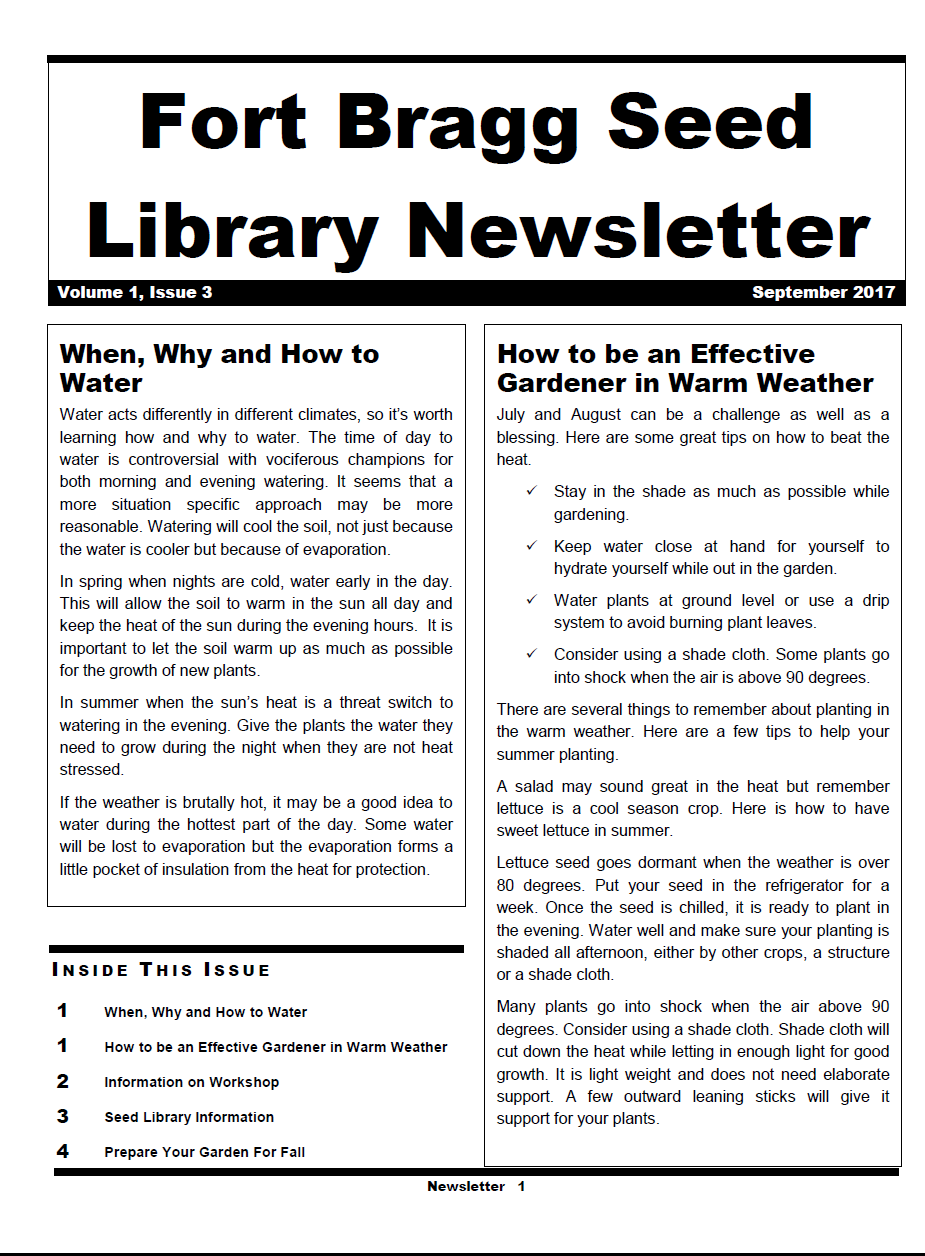
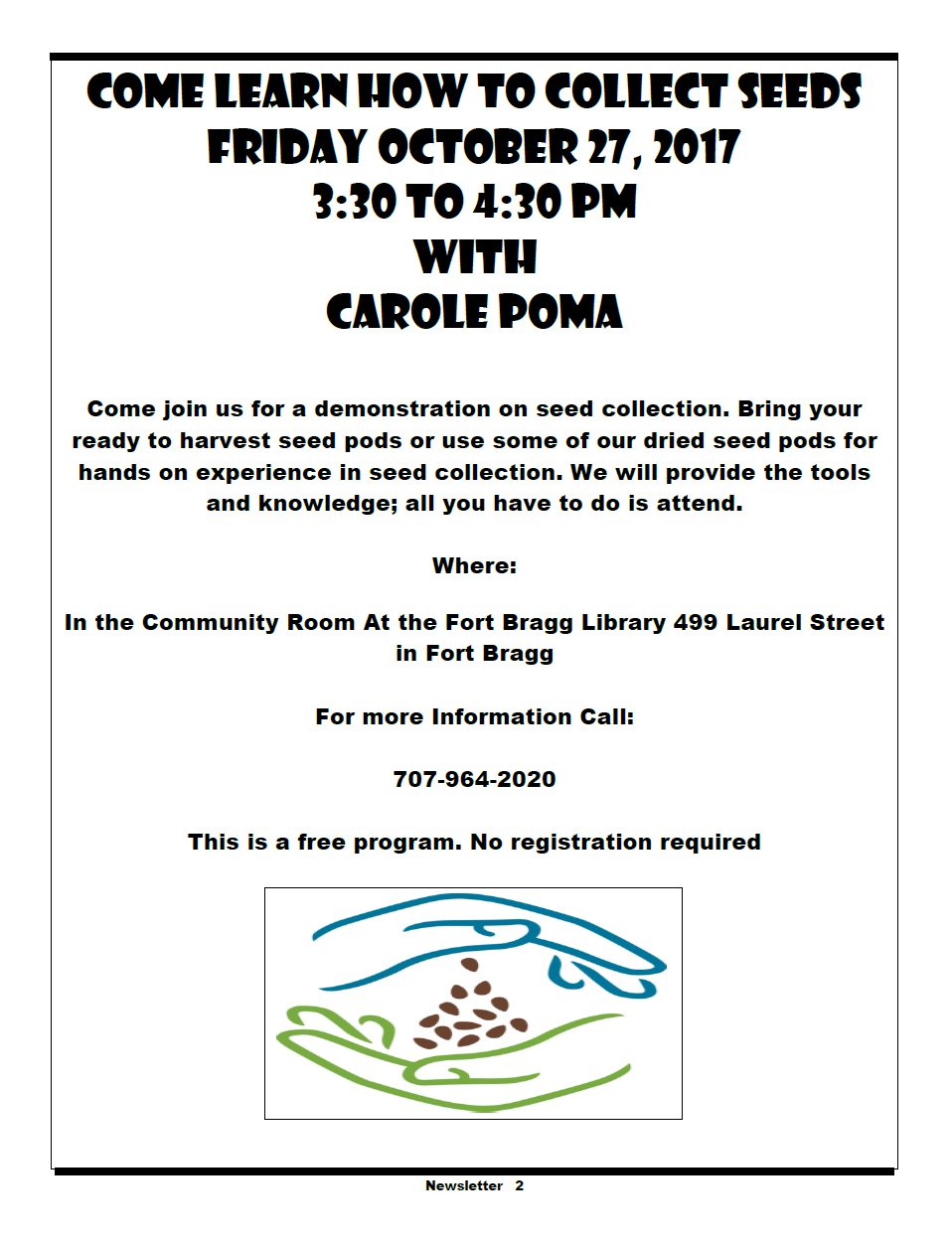

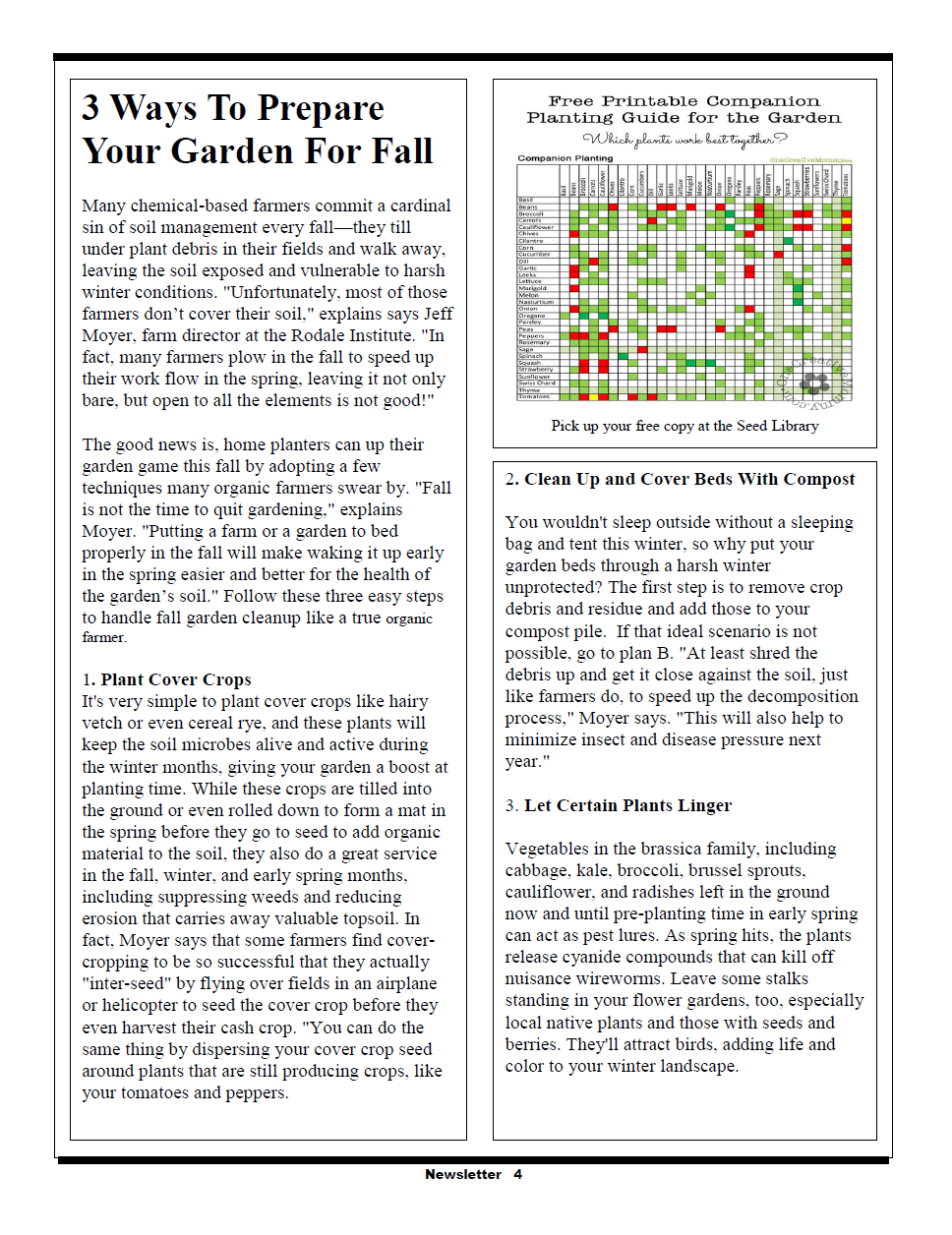
JULY/AUGUST NEWSLETTER
P l a n t i n g & S e e d
C o l l e c t i n g
I n s t r u c t i o n s
Courtesy of Dana County, Oregon Seed Library
Beans Planting : Sow seeds outdoors after danger of frost has passed and soil and air temperatures have warmed. Plant seeds 2″ apart and 1″ deep in rows 36-48″ apart. Beans prefer full sun. Provide support for pole beans. Harvest snap beans frequently for increased yields.
Seed Collection: Bea n flower s a r e s elf-pollinating and almost never cross-pollinate. As a precaution never plant two white seeded varieties side-by-side if you intend to save seed because crossing may occur but not be visible. It is always best to save seed from plants that ripen first and are free from disease. Pods are ready for harvest when some are dry and the remainder have turned yellow, about 6 weeks after the pods were of fresh-eating quality. Cure the pods in a warm, dry place for 1 to 2 weeks.
Seed Cleaning: After the pods are fully dry, crush in a cloth or burlap sack, winnow the seeds from the chaff.
Beets Planting: Starting beets in doors is n o t recommended. Beets g r o w fairly w ell in all most any soil, but because of their extensive taproot, they prefer deep, moist, rich soil. Prepare the seedbed by working in 2-3 inches of compost or well-rotted manure prior to planting. Beets germinate in soils as cool as 45°F, and the seedlings are frost hardy. Plant beets in rows 12-16 inches apart. Cover the seeds with sifted compost, loose soil, or vermiculite and water evenly. For uniformly sized beets, thin when the seedlings are 3-4 inches tall. Thinning’s can be used as pot greens or in salads. Keep well-watered, especially during root development. The 5th and 6th leaf stage is the most critical time for beets to stress. Sudden changes in temperature or moisture will increase zoning (ring formation in the root) and lead to premature bolting.
Seed Collection: Beets a n d Swiss ch a r d will cro s s pollinate, as they are from the same species. Beets/chard must be separated by wind-proof caging, bagging or up to 2 to 5 miles of distance to ensure purity as their wind-blown pollen is exceedingly small and light.
It’s easy to leave the base and center of chard plants to over-winter, flower and produce seeds while still eating plenty of leaves. However, to save seed from beets you’ll have to plant 20 to 30 plants to leave in the ground to over-winter if you want to get seeds. You can harvest tasty beet greens for the first part of the season, and you can crowd the plants a bit. You don’t have to pam-per them with lots of room, water and fertilizers to get plenty of seeds in the spring—just make sure they’re big enough to get through the winter and re-sprout. Allow beet seeds to fully mature and become dry on the plants before harvesting. After final drying the seeds can be easily rubbed off the stems. Beet seeds will last for up to 5 years if properly stored.
Kale Planting: Italian heirloom that dates back to the eighteenth century. Bluegreen strap-like leaves are 3″ wide by 10-18″ long with a heavily savoyed texture. Excellent flavor that is enhanced by frost. Best eat=en when leaves are small and tender. 62 days from transplant. Sow seeds indoors ¼” deep. Plant out just before the last frost. Kale is most tender and delicious after a frost. Harvest can continue even after snow.
Seed Collection: Most kales are Brassica oleracea, and will cross with other members of this species such as cabbage, collards, broccoli and cauliflower. Siberian Kale, however, is Brassica napus and will cross with rutabagas and rape, but will not cross with the members of B. oleracea. Let seed pods mature and dry on the plants before harvesting, or the seeds will not be fully mature. Harvest quickly after drying, though, as the pods often shatter and drop their seeds soon after they dry.
Lettuce Planting: Sow seeds outdoors as soon as soil can be worked in spring. Plant seeds 1″ apart and ¼” deep. Seeds will germinate in 7-14 days. Thin to 6-8″ apart for Looseleaf, 10″ apart for Romaine, and 10-12″ apart for Crisphead. Sow continuously for a constant supply of lettuce. Lettuce is best grown in cool-er weather and prefers full sun or partial shade. There is only a slight chance of cross-pollination be-tween lettuces. As a precaution separate by 25′ from other varieties that are going to seed.
Seed Collection: Allow plants to bolt and form seed stalks. It is best to collect seeds from plants that are slow to bolt so that you don’t select seeds for fast bolting lettuce. Seed heads may need to be protect-ed from bird damage and rain when drying. Harvest the seed heads as they begin to dry, or shake them into a bag to avoid loss from shattering. You can also pull the entire plant up when enough seeds have formed and hang it upside down to dry.
Seed Cleaning: Lettuce seeds are small and light. Rub the heads in your hands or flail them, then carefully screen the plant material. Use a screen of proper size so the seeds will fall through. This will leave you with a mixture of seeds and seed fuzz. If you want your seeds to be cleaner, select a screen size that is smaller than the seeds and gently rub the seed and fuzz against the screen to separate the fuzz.
Peas Planting: Peas thrive in cool weather. Sow seeds outdoors as soon as soil can be worked in spring. Plant seeds 2-3″ apart and ½-1″ deep in rows 24″ apart. Seeds will germinate in 7-14 days. Double rows of peas can be planted on each side of a trellis. Pea varieties should be separated by 50′ to ensure pure seed. Select the healthiest plants for seed.
Seed Collection: The fruit is a pod that goes through two stages of development. The first is the flat-pod stage, in which the pod elongates and widens; the second is the round-pod stage, in which the seed fatten and mature. A color change in the seeds and pods indicates harvest maturity for seed collection. Harvest pods when they are dry and brown and when the peas rattle inside if the pods are shaken. If birds start eating the seeds before the pods are completely dry, they can be harvested slightly green and brought indoors to dry.
Seed Cleaning: Store in a warm, dry place for 1 to 2 weeks then shell peas from the pods by hand. Flail larger quantities in a cloth bag or pillowcase or gently strike plants on the inside surface of a garbage can.
**Peppers Planting: Sow seeds indoors ¼” deep 8 weeks before last frost. Seeds will germinate in 14 days. Peppers germinate best in warm soil, so gentle bottom heat may be helpful until seedlings emerge. Plant seedlings outdoors 12-24” apart when soil is warm. Some peppers will cross-pollinate, so separate by at least ½ mile or plant in insect-proof cages covered with window screen. Peppers prefer full sun. Seed Collection: Select peppers that are ripe, fully colored, and show no signs of disease to save for seed. Scrape out the seeds and spread them on a screen or paper towel to dry for about 2 weeks.
Seed Cleaning: Pepper seeds do not need any type of cleaning. Once they’re dry, they’re ready for storage.
**Peppers, Jalapeno Planting: Start seeds in doors 8 weeks before last frost. Plant 12-24 “ apart. Open-pollinated. Hot, hot, 3×1″ sausage-shaped blunt fruits mature early. Characteristic brown netting appears as fruit ripens from dark green to dark red.
Seed Collection: Peppers within the same species can be safely isolated by 500 feet of separation, or they can be caged since the plants are not overly large. Allow peppers to ripen and dry fully on the plants before harvesting the pods. Wash your hands thoroughly with soapy water after harvesting hot pepper seeds, since the residues will burn eyes and lips for some time after contact!
Spinach Planting –Very hardy. Must be planted as soon as the ground can be worked in the spring to avoid early bolting. For fall crop try late July–Aug. sowing; to overwinter, sow late Aug.–Sept. Heavy nitrogen requirements, but avoid applying high-nitrogen fertilizers shortly before harvest to prevent high nitrate levels in the leaves. Pick large leaves often for heavier production.
Seed Collection Beets, Swiss chard, and Spinach will cross-pollinate, as they are from the same species. Beets/chard must be separated by wind-proof caging, bagging or up to 2 to 5 miles of distance to ensure purity as their wind-blown pollen is exceedingly small and light.
It’s easy to leave the base and center of chard plants to over-winter, flower and produce seeds while still eating plenty of leaves. However, to save seed from beets you’ll have to plant 20 to 30 plants to leave in the ground to over-winter if you want to get seeds. You can harvest tasty beet greens for the first part of the season, and you can crowd the plants a bit. You don’t have to pamper them with lots of room, water and fertilizers to get plenty of seeds in the spring—just make sure they’re big enough to get through the winter and re-sprout.
Allow beet seeds to fully mature and become dry on the plants before harvesting. After final drying the seeds can be easily rubbed off the stems. Beet seeds will last for up to 5 years if properly stored.
**Swiss Chard Planting: Sow seeds outdoors in early spring when soil temperature is at least 50˚F. Plant seeds 4″ apart and ½” deep in rows 20-24″ apart; thin to 12″ apart. Chard can also be started indoors 5-6 weeks before transplanting out. Prefers full sun but tolerates partial shade. Swiss chard withstands light frost. Varieties must be separated by ½ mile from all other Beta vulgaris when going to seed.
Seed Collection: Chard is a Biennial and will flower the during the second growth sea-son. In warmer climates, chard can be left in ground to overwinter, mulch it well, and let it grow into a full plant the second year when it will flower and seed. In northern climates, trim leaves to 2″ and store roots in sawdust or sand in a root cellar. Roots will store 4-6 months at 32-40° . If you’ve overwintered roots indoors, replant them in the garden in spring. discard any that are damaged, rotted, or shriveled. If you’ve overwintered in your garden, remove the mulch once you see new growth beginning. The plants will produce some leaves first and then send up a seed stalk. Do not cut any leaves for eating; let them stand to nourish the plant.
Seed Cleaning: After most of the flowers have turned brown, remove the stalk and further dry it in a cool location for 2 to 3 weeks. Remove the seed balls (these are actually dry, shriveled fruits) from the stalk by hand, or place the stalk in a bag and flail. Winnow.
**Tomato Planting: Sow seeds indoors 6 weeks before last frost. Plant ¼” deep. Seeds will germinate in 7-14 days. Transplant outdoors 24-48″ apart when soil has warmed. Support indeterminate plants with a cage or trel-lis. Tomatoes prefer full sun. Cross-pollination between modern tomato varieties seldom occurs, except in potato leaf varieties which should be separated by the length of the garden.
Seed Collection: The fruit is the berry and should be picked fully ripe and ready to eat. . Pick at least one ripe fruit from each of several plants.
Seed Cleaning: Immediately after harvest, squeeze the pulp and seeds from the fruit into a container, add enough water so that the seeds are covered by about two inches, and let it ferment several days at or below 70 degrees F. Stir several times a day. The fermentation process takes about 4 days, the water will become cloudy and slightly foamy. Nonviable seeds will float, while seeds having the best chance of being viable will sink. Pour off the water and the floating seeds. Spread the seeds in a single layer on a pa-per plate or screen.
Herbs/Flowers Basil (Ocimum basilicum) – Planting: Sow seeds outdoors when the soil is warm and the temperature does not drop below 65° F. Can be started indoors 4-6 weeks before planting out. Space plants 4-6″ apart in all directions. Plant seeds just beneath the surface. Seeds germinate in 5-30 days, so keep moist. Prefers full sun and rich, well- drained soil. Basil will cross-pollinate with other varieties of basil and must be sep-arated by 150′ while flowering.
Seed Collecting: The small perfect flowers are borne in racemes. Harvest the clusters when they brown.
Seed Cleaning: Spread the clusters on screens to dry, then rub or thresh to remove the nutlets. Put the nutlets and chaff in a bowl and gently swirl them around. The very small seeds will sink to the bottom, then you can rake off the chaff with your hands.
Chives (Allium schoenoprasum) – Planting: Sow seeds indoors ¼” deep 4-6 weeks before last frost. Seeds will germinate in 7-14 days. Transplant outdoors 4-8″ apart as soon as soil can be worked in spring. Established plants can easily be divided in both spring and fall. Remove spent blossoms regularly to pro-long blooming. Chives prefer full sun to partial shade. Chives are a perennial that produces seed each sea-son, and may be also be direct- seeded in very early spring. Chives will not cross with any other Alliums.
Seed Collection : The fruits are capsules, each containing shiny black, flat, angled or round seeds. Har-vest the seed heads when they have begun to brown, but before seed-shed.
Seed Cleaning: Spread the drying heads on screens to dry completely; then rub, thresh, or flail to remove the seeds.
**Plants with red stars require more effort because they should be started inside and planted out-side as seedlings. Swiss Chard is starred because it is a biennial.
For more information, visit
www.seedsavers.org/Education/Seed-Saving-Resources/
www.facebook.com/DaneCoSeedLibrary
http://www.finegardening.com/collecting-and-storing-seeds
April 2017
**Charts courtesy of www.seedmatters.org. Please visit their website for more seed saving and gardening tips.
Printable version of Six Tips for Saving Seed
Printable version of Seed Saving Chart
March 2017
 Bountiful Gardens
Bountiful Gardens
Garden Tip of the Month
For March
When starting seeds this month, remember that the most important part of the plant is invisible, the roots. How the roots develop will shape everything else about the plant, and will determine your success or failure in the garden.
Once you know what kind of roots the plant has, you will know many of its needs. Like how long it should stay in the pot or flat. And once you know that, you’ll know when to sow the seeds.
Here is a guide to root types, and how to treat them. We recommend heat mats or a warm surface (top of a refrigerator?) for seed germination and root development. Of course, the little plants also need plenty of light. See the links at the end for more on that.
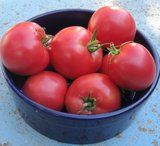 Movers
Movers
Plant these now
Movers have a fibrous, dense root system that is actually stimulated by transplanting. In studies at Cornell University, cabbages had much larger root systems at maturity if they had been transplanted–and those that had been transplanted twice had the largest of all! These slower-growing, transplant-loving crops can stay in the pot for about a month, then can be transplanted outside or to bigger pots. While transplanting doesn’t bother them, crowding does. Move them if needed to maintain adequate spacing. Most are fairly heavy feeders, needing fertility to maintain growth. Prime Movers: tomatoes, peppers, eggplant. (Plant outside in May.) Cabbage, broccoli, cauliflower, collards, kale. (Transplant outside in April.)
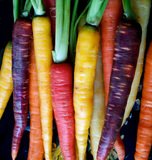 Divers
Divers
Direct-sow these, or start just 2 weeks early, and transplant carefully. Divers make a few, large, succulent roots that are brittle, like a good carrot or a bean sprout. They break when a cabbage root would bend. Divers do not like transplanting, and should be either direct-sown, or transplanted when quite young, before their roots get too big. On the other hand, they are not so worried by crowding. You can shoehorn them in among earlier vegetables or a cover crop. They find nutrients on their own, and do not need such heavy inputs as the rest. Popular divers: beans, beets, carrots, chard, cilantro, dill, fennel, peas, parsnips, poppies, and radishes.
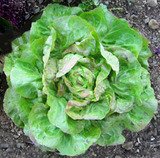 Sprinters
Sprinters
Plant every few weeks as soon as the ground can be worked. Keep in pots only 2-3 weeks. Sprinters are the juicy, leafy, fast-growing plants that mature very quickly. They have been bred for crisp juicy leaves, mild flavor, and fast growth. They can be sown in place or transplanted once–but then they need to get down to business and finish up. You won’t get a second chance with these–give them the water and fertility they need at planting time. They bolt quickly when mature, or if they get pot-bound, so don’t leave them in pots more than a month. Classic sprinters: Asian greens, lettuce, spinach.
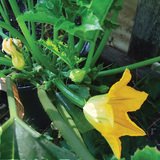 Sprawlers
Sprawlers
Start these in mid to late April. Or direct-sow after frost.
Sprawlers are large plants with far-ranging, but fragile, root systems. Give them a sunny position after your last frost date, even if it means cutting an opening in your winter cover crop, or planting the young starts among your spring peas and lettuce. They love organic matter, and want a lot of it. The edge of a compost pile, or the area where one was, is a favorite situation for them. Some sprawlers: sunflowers, okra, corn summer and winter squash, melons, cucumbers, pumpkins, watermelons, and gourds.


